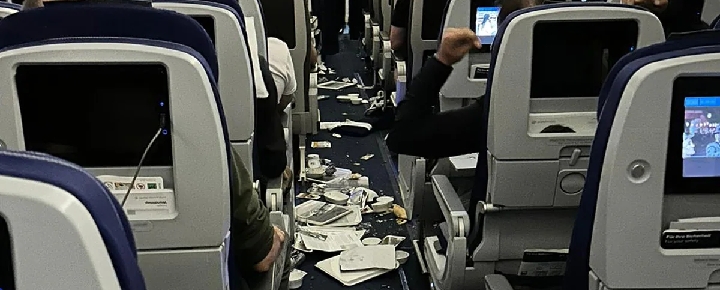New research on clear air turbulence (CAT) is alarming from the American Geophysical Union and the University of Reading (in the United Kingdom). They report significant increases in CAT based on what’s happened over the past 40 years. The future looks rocky; we suggest staying buckled.
The study’s focus was mainly conducted over the Atlantic and US mainland, which showed a 55% increase in severe or greater CAT in 2020 compared with 1979.
Hawaiian Airlines air turbulence mass injury event.
Following last year’s December 18 mass casualty incident, turbulence has remained at the top of our minds and perhaps yours. Flight 35 encountered an extreme clear-air turbulence event as it was approaching Honolulu for landing. Some three dozen persons were injured, 20 went to the hospital, and eleven were seriously injured.
That resulted from the turbulence and a severe altitude drop in passengers hitting the overhead luggage bins and the A330 ceiling. It occurred just before landing procedures, about a half hour from Honolulu. The flight was operating in clear weather with nothing notable on the radar. The Hawaiian Airlines pilot reported a vertical cloud appeared in front of the aircraft so rapidly that he could not navigate around it.
NTSB reported that the cloud caused extreme air turbulence, a drop in altitude, and injuries to passengers, crew, and aircraft. The Association of Flight Attendants (AFA) also said airline turbulence will become more common.
“Severe weather increases chances of turbulence, and due to climate change, these kinds of incidents will only continue to grow.”
Tahlor Garland, AFA.
And while technology arguably makes turbulence easier to predict and plan for (try telling affected passengers that!), it hasn’t prevented or explained some terrible incidents like the one that happened.
In March a Southwest Hawaii flight also encountered severe turbulence.
A Southwest Boeing 737 MAX8 plane also encountered extreme turbulence following departure from Honolulu and headed for the mainland. Passengers gave kudos to the Southwest pilot and crew. There was no official comment from Southwest about the event nor do we know the extent of any injuries.
Another 37 were injured in turbulence before Air Canada diverted to Hawaii.
In 2019, this incident injured dozens of passengers and flight crew on an Air Canada 777 plane when it hit extreme, clear air turbulence two hours southwest of Hawaii. The flight diverted to Honolulu, with 30 people taken to the hospital.
Should you worry about Hawaii flight turbulence?
For Beat Hawaii editors, it has increased our awareness of the potential for clear air turbulence at any point during a flight, with or without any notification. So we are doing as pilots have always said: use your seat belt whenever you are seated.
Has this changed your behavior on flights to Hawaii and elsewhere? The FAA concludes, “Passengers can easily prevent injuries from unexpected turbulence by buckling their seat belts at all times.”
NOAA and National Weather Service to the forefront of air turbulence.
A resource with which we were unfamiliar previously is the Aviation Weather Center (AWC). It is run by NOAA and the National Weather Service (NWS). You’ll find the site at https://aviationWeather.gov. The AWC provides a fascinating glimpse of aviation-related weather information, such as convention forecasting, and a novel interactive Flight Path Tool for evaluating all weather information from the organization that relates to a given air route.
“We’ve made tremendous advances over just the past few years, thanks to improved weather forecast models with more data going into and better understanding of the science in these models. That results in better forecast information across the board, including when evaluating the potential for turbulent conditions.”
Jennifer Stroozas, Aviation Weather Center meterologist.
Other tools within the product suite include their Graphical Turbulence Guidance tool that provides SIGMETs (significant meteorological hazards) related to turbulence, including pilot reporting, both graphically and in text. The products will help planes fly at all altitudes from 1,000 feet to 50,000 feet.
NOAA can now offer new products with better predictions of air turbulence. They said they’ve “Definitely seen improved NOAA and NWS forecasts over the past decade through ensemble prediction tools and more data.”
The cause of air turbulence.
Study partner University of Reading said, “We’re looking for rapid variations in wind speed and altitude that create wind shear. It’s also analogized like this. Air is fluid, just not in the same way as water. But a river or the air we fly in can be calm or feature hidden rapids that create choppy air travel. These currents can sometimes be found as high up as flights are. Clear air turbulence (CAT) is even more challenging to predict. Better forecasts are wanted by the airline industry and pilots in particular.
Check out the new NOAA tools for air turbulence.
Go to https://beta.AviationWeather.gov to use the new tools directly.






Yikes, even BOH isn’t immune from climate deniers. I’m guessing these are the same people that ignore sunscreen rules, touch sea turles, and trash the beaches. When they see “aina” they think “Ima” do what I want. So sad.
Climate change? LOL give me a break! Just got back from Hawaii. It was smooth all the way and back from Florida. Good job American and Hawaiian Airlines! Aloha
Climate change?
I’m disappointed that aviation people like yourselves didn’t even bring up the new 42 Optimized Profile Descents put into place by the FAA and mentioned in their press release dated Jan. 13, 2022.
The OPDs replace the stair step landing profile that was used up to that point. It was introduced to save fuel and lessen emissions.
I have heard it mentioned that the profile may put aircraft into CAT situations the previous method avoided, but I have no idea.
just glad im in the end stages of life. Not too much good happening around the world anymore. Overcrowing and abuse for extreme weather. Few believe in climate control, even though it is right in front of us today.
I agree with the other commenters. The article talks in terms increase in “turbulence hours” from the 1970’s, but a more insightful statistic would be turbulence incidents per 100,000 flights ( or some other number). The number of flights in the US has increased astronomically since the 1970s. So, of course, the number of reported turbulent incidents would also increase. Duh. Their article never mentions the number of reported turbulent incidents as a percentage of total flights flown. There was a great business book published years ago – “Lying with Statistics “. It’s a slippery slope.
Turbulance is the very reason babies should be in car seats strapped to their own seat. I shudder at the thought that it will probably take an injury from someone getting hit by a flying baby or an infant death from turbulence before car seats are implemented. Think about how fast planes fly compared to cars, where baby seats are required to be used for safety.
I’d just be happy if (Most)folks would not fly with their children. Parents have no idea how to control or raise their children properly and it is evident on each lonnnnnng lonnnng flight to Hawaii.
Didn’t take long for a reference to “global warming” aka “climate change” to be referenced as the root cause of CAT now did it! I believe that there is literally nothing going on anymore that they cannot and will not somehow, someway tie to global warming and their desperation is really starting to show!
Don. The vast majority of people who have dedicated their careers to studying climate agree that climate change is in fact an issue that needs to be dealt with. No politics, no emotion, just reality from people that know what they are talking about. On the other hand you have people with no expertise in climatology making a lot of money on talk radio or cable news stirring people up with false narratives and conspiracy garbage. You can choose who you want to believe.
Just FYI on the accuracy of climate alarmists over the past 50 years.
Spoiler: None of these things happened.
→ 1969: ‘Everyone will disappear in a cloud of blue steam by 1989.’
→ 1970: Ice age by 2000
→ 1974: Ozone Depletion a ‘Great Peril to Life’
→ 1980: ‘Acid Rain Kills Life in Lakes’
→ 1988: Maldives completely under water in 30 years
→ 2000: ‘Children won’t know what snow is.’
→ 2002: Famine in 10 years
→ 2008: Arctic will be ice-free by 2018
→ 2014: Only 500 days before ‘climate chaos’
Actually, one of these is kind of true – “Children won’t know what snow is”. Applies to a lot of locals!
Ha, your right on that one. Climate change, yes. Climate Emergency – No ! the sky is falling Al Gore was shouting from the rooftops 40 years ago, and were still here. Friends of mine were in the Maldives last year, there dredging sand and building new islands. Dont seem to worried about the rising oceans.
I 100 percent disagree and am very disturbed at this thought process! I could say some mean but intelligent statements here, but it goes on deaf ears!
While you should always stay buckled when you’re flying 500mph in a tube 30,000 feet in the air, I think this is just more climate change FUD (fear, uncertainty, and doubt). I appreciate that climatologists are trying to create better models and tools just like in any other industry, but it always seems to be “we are going to die in 10 years, or 5 years (Greta!) if we don’t spend every dime on climate solutions.
None of these dire predictions have ever come true. Still here. Still breathing. Waikiki is not under water last time I was there.
Try to stop worrying so much. Keep your seatbelt on, listen to your cabin crew, and trust your pilots.(Well if you have experienced pilots I mean… you might have a pilot that was hired to fill a quota, but let’s leave that for another day)
On our return flight from Oahu last year the turbulence was on the second leg of the flight from SEA to ORD.
Strong storms over the Rockies & northern Plains made a very bumpy flight, so much so that the captain took a detour of several hundred miles around the storm system.